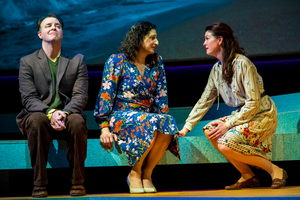Review: SUPERMAN BECOMES LOIS LANE at History Theatre

Saint Paul's History Theatre has a clear mission: to develop and produce plays that deal directly with local, statewide, or regional history, sometimes distant in time, and sometimes up close to the present. To their great credit, they do so in a wide variety of styles: in addition to the realistic dramas you might expect given their intentions, they mount comedic and sometimes brilliant musicals, politically charged works, and documentary pieces. Usually these skirt the dangers of didacticism with artful writing and staging. Always they are performed with skill and commitment by actors from the Twin Cities' deep well of experienced talent.
SUPERMAN BECOMES Lois Lane fits directly into this mission, tracing the transgender transition of a local politician. Susan Kimberly is a fledgling playwright who was once an investment banker, a lobbyist, and chair of the Saint Paul City Council in her earlier identity as Bob Sylvester. (She also served on the board of the History Theatre for a decade.) Bouncing around a bit in time, she shares the winding and sometimes bumpy course of her courageous journey to live a life consonant with her inner identity. Post transition, she rose to be deputy mayor of the city.
Born in 1942, the playwright knew herself to be a girl from the time she was three. But it was not until a near fatal car crash in 1982 that she resolved to stop living as Bob and emerge as her true self, Susan. Her path to doing so causes the dissolution of her 10 year marriage, though she and her former wife Mae remain supportive friends. We witness crucial relationships with several therapists and her involvement with some of the outlier practices of identity therapy in the 1980s, exploratory trips to both New York and Hollywood, the difficulties inherent in negotiating her transition with professional colleagues, and her confrontations with glass ceilings and derogative humor once she comes out publicly as a woman.
There's a great deal of reportage here. The play is full length, two acts with an intermission. Giving voice to the biographical specifics of one transgender pioneer's life is a service to all of us who choose to work toward a more inclusive society. We need more stories, and more diverse ones. SUPERMAN BECOMES Lois Lane was first written in the 1990s, and consigned for years to a drawer; it has undergone a lengthy development process at History Theatre over the last two years.
And yet, I could not help but feel that this piece needed further editing: less reportage, more art. I also wanted some deeper exploration of some of the complexities it skirts. For instance, at one point Susan boycotted the 'grooming and decorum' classes mandated by a gender transition program, saying "I'm a feminist: I want to become a woman, not a caricature of one." That's a promising gambit but it is not further explored.
The most successful theatrical choice of the script is to give two actors the job of playing the lead character. Freya Richman (herself a transgender person) plays Susan, and she is matched by Sean Michael Dooley as Bob. Fond allies, they support one another, and they witness each other's interactions with additional characters. I was struck by Dooley's careful physical work when he was listening; he often adopted a tentative pose, with his feet close together or twisted around one another or pigeon-toed. Richman as Susan has to carry the play, including many moments of awkwardness or apology. Jamie White Jacimiec as Mae is compassionate and credible. An ensemble of three additional actors carry all the remaining roles, morphing with simple costume and attitudinal changes.
The whole unfolds on the largest set I've seen at History Theatre: a series of at least 18 levels leading up to an off center apex, framed with two large projection surfaces. The palette is very 80s: turquoise, mustard, maroon against a grey base. Scenic design is by Michael Hoover. Staging is kept simple except for one experimental movement sequence involving the whole company late in the play, perhaps intended as a break from what is otherwise a fairly speechy presentational approach with two characters in conversation at a time. Laura Leffler directed.
I applaud the History Theatre's willingness to develop new material, as well as what seems to be significant effort to assemble a gender diverse team to work on this particular play. The program includes a useful glossary of terms and a guide about how to support trans people in daily life; I wish it had a reading list as well. Perhaps I want too much!
Photo credit: Rick Spaulding
Reader Reviews
Videos

